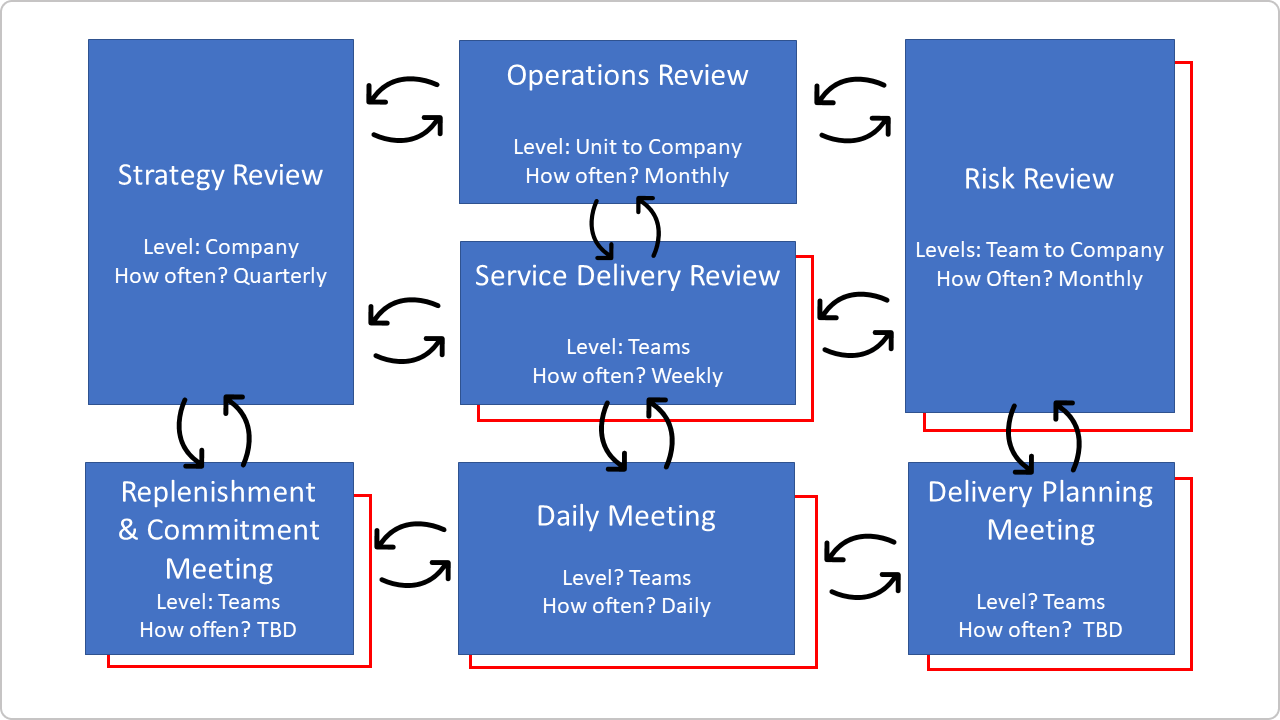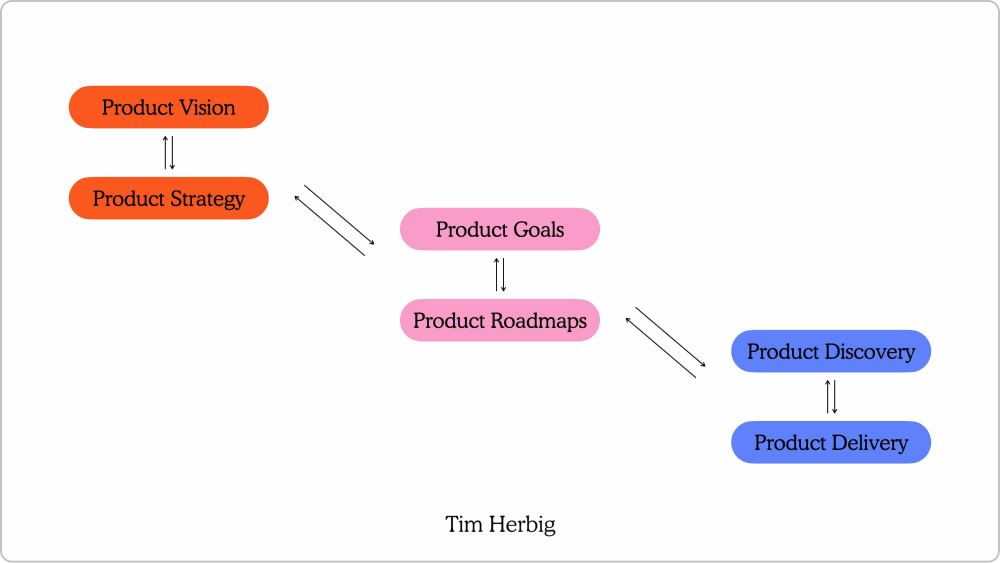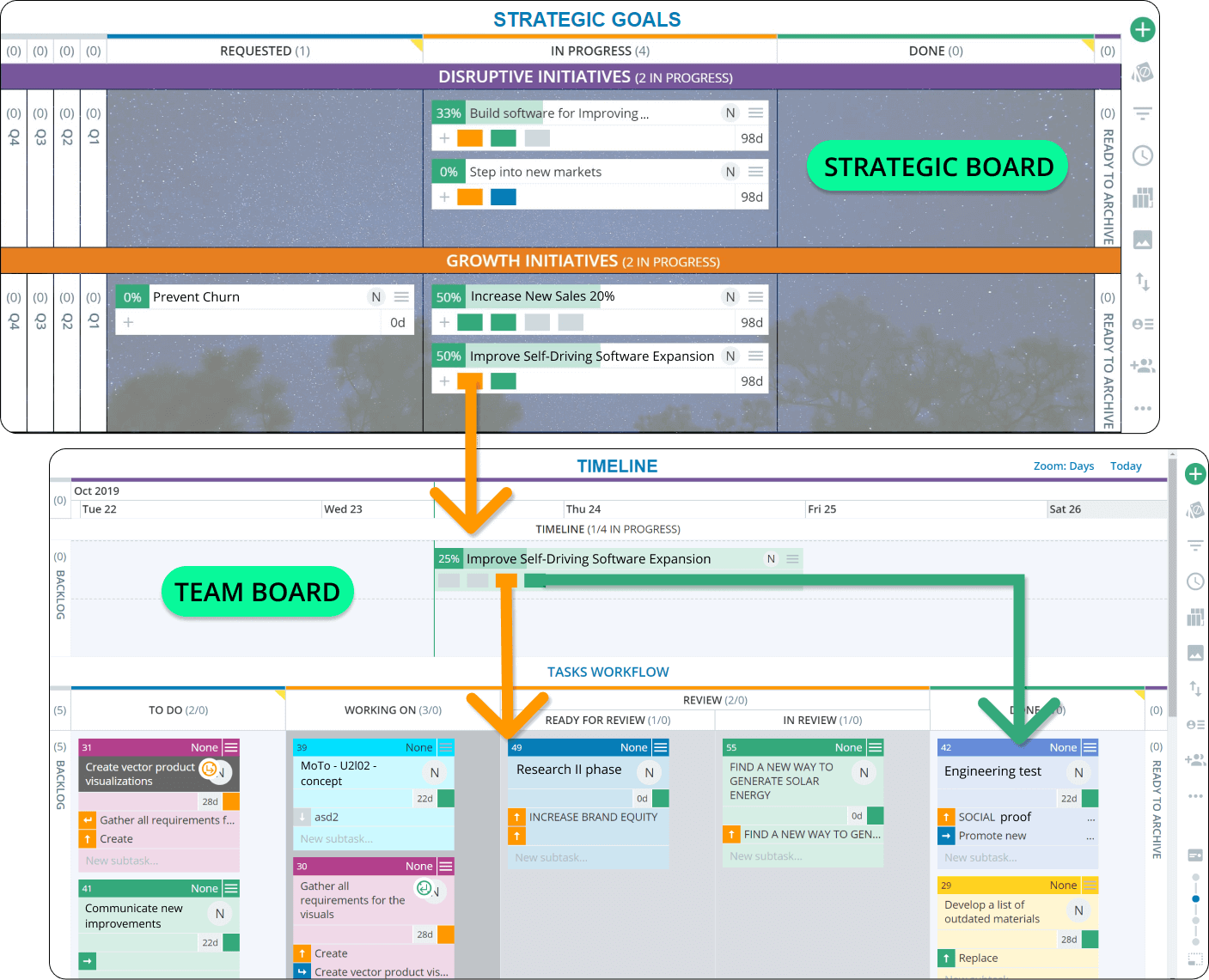The OKR framework has gained great popularity over the years due to its application for connecting strategic direction with actual execution. One of the fields where OKRs can be successfully applied is product management. In today’s dynamic market environment and constantly changing customer requirements, measuring success in the delivery of features is no longer a viable option.
That’s why more and more product managers combine OKRs with their product strategy to shift their focus to outcomes and deliver on their strategic vision.
Getting Started with OKRs in Product Management
In a product management setting, OKRs are about establishing clear (and inspirational) goals for the development of a product and measuring their progress through actionable key results. Product management OKRs, however, should not be confused with the Product Strategy.
While the latter represents the overall product direction regarding its value delivery, the former is about defining goals that build on your product’s strategic journey. OKRs in product management help to bridge the gap between those goals and the final piece of technology that customers get in their hands.
That’s why it’s good practice for product managers/directors to use OKRs across the entire product development cycle and on multiple hierarchical levels. For example, you can set goals and measurable key results that support the Product Strategy, and the Product Roadmap, including the actual Product Delivery.
But before we dive into best practices for creating them, let’s take a look at why OKRs are important for delivering better products.
The Importance of Product Management OKRs
1. Focus on Priorities, Not Only on Maintaining a Backlog
In Agile project management, the backlog is the main weapon in every product manager’s arsenal. And while replenishing the next work in line is important, there are always bugs, technical debt, support requests, etc. that can lead managers astray from their true priorities. Setting up objectives and key results within a product team helps everybody stay in line with a strategic direction.
One example is to set 3-5 team OKRs per quarter which can be connected to higher-level OKRs (on the Product Strategy). This approach will keep you aligned with the main business priorities while executing the day-to-day development work.
2. Translate Product Strategy into Actionable and Measurable Goals
Creating product management OKRs allows Product Directors or VPs to better communicate the overall direction of their product with the development teams. Setting OKRs on a strategic level and then chopping them down into more specific goals on a team level maintains a constant information flow between strategy and execution. One of the best practices here is to have the appropriate Agile ceremonies or cadences for your scenario where development teams can discuss their own objectives and key results and connect them to the strategic ones.
 Cadences in Kanban
Cadences in Kanban
With such a structure in place, OKRs can help you set the foundations of true agility and adaptability within your product management operations.
3. Increase Team Morale
There’s a common belief that OKRs are just a management thing. In fact, development teams can benefit as much from OKRs as product managers.
That’s because, in a product management setting, OKRs aim to shift the conversation from features to outcomes. The idea is to use them as a method to portray the team’s contribution to the product’s growth instead of only measuring released features. This increases the team’s morale, which can eventually improve the quality of the final product.
How To Create Meaningful OKRs in Product Management?
As we’ve given a few reasons why OKRs can be an important asset for a product team, let’s now take a look at how you can actually create them. To do that, there’s one important distinction you need to be aware of.
Outcomes vs. Outputs
You can think of outcomes as the “Why” behind certain actions. They refer to the business results that create an impact for the end customer. Outputs, on the other hand, are the everyday actions that you take to fulfill a business goal. An easy way to think of them is as quantities of finished work.
Traditionally, in product management, the focus has mostly been on outputs (ex. Deliver 5 new log-in security improvements by X date). In Agile, however, more and more product teams shift their thinking to delivering outcomes (ex. Improve the app log-in security to keep customers’ credentials safe). The main difference here is how developers think of and measure their success.
When using outputs as your baseline, once you deliver your chosen 5 product improvements, your key result should be complete. However, there is no real way to measure if you’ve actually created customer value. What if your 5 security improvements were not enough to ensure customers’ details remain safe?
With the outcomes approach, things are different. When you’re aiming to improve the log-in security process, you can actually measure whether you’ve created an impact for the customer. For example, you can run surveys to determine whether your KR is actually complete and if there is value that you’ve provided.
One last point here. There are many different situations, so don’t blindly try to make all of your OKRs outcome-based. There’s nothing wrong with using outputs as a baseline for some of your key results. Even then, just try to think in terms of value instead of delivered work.
Best Practices and Examples of Product Management OKRs
First of all, let’s make it clear that there isn’t a single best practice for creating OKRs for product management or any other company function. This is more of an art than a science.
However, specifically for product management, you can set OKRs in terms of Product Vision and Product Strategy, which are progressively cascading into OKRs for what you’re going to deliver.
 Cascading OKRs across Product Management, Image Credit: https://herbig.co/
Cascading OKRs across Product Management, Image Credit: https://herbig.co/
In practice, this can be done with the help of OKR software with multiple Kanban boards that visualize both objectives and key results on different hierarchical levels across the product management lifecycle. The idea is to map your OKRs into a single place and connect them to different work items (epics, releases, user stories, etc.) that create the actual product development flow. This way, product managers can have a complete picture of what they should prioritize in their roadmaps, so it aligns with the high-level strategic goals that your product aims to achieve.
 Visualization of product management OKRs on different hierarchical levels using multiple Kanban boards
Visualization of product management OKRs on different hierarchical levels using multiple Kanban boards
Another way that a lot of product managers use to approach their OKRs is by creating separate goals for different stages of the product development process (Conceptualization, RandD, Product Release, etc.). Of course, this will particularly depend on the size of your organization.
It’s also important to create your Objectives and Key Results in collaboration with all relevant stakeholders. This doesn’t include only management but all other cross-functional team members. Another crucial thing is to engage in regular reviews throughout your chosen OKR cycle (ex. quarter). Make sure you frequently measure the progress of OKRs and also inspect whether they’re still relevant in terms of your top-level strategy.
Let’s now take a look at a few OKRs examples of how different they could look across the Product Management function in your company:
1. OKRs for Product Discovery and Research
| Objective |
Determine the Need for a Capacity Management Module in the Product |
| Key Result 1 |
Collect 100 Survey Responses to Analyze Customer Demand |
| Key Result 2 |
Analyze the Capacity Management Capabilities of Up to 5 Competitors |
| Key Result 3 |
Build Wireframes to Collect the Feedback of At Least 30% of Our Customer Base |
2. OKRs for Design and Development in Product Management
| Objective |
Improve the Product’s UI and UX to Reflect Customer Needs |
| Key Result 1 |
Test 3 New Feature Designs Among Our Customer Base and Implement the Winning Variation |
| Key Result 2 |
Optimize File Storage and Reduce The Speed of The Application by 30% |
| Key Result 3 |
Increase the Average User Time by 5% |
3. OKRs for Product Quality and Maintenance
| Objective |
Increase the Customer Satisfaction Rate of the New Reporting Module |
| Key Result 1 |
Cut Down All Known Reporting Defects in the Product |
| Key Result 2 |
Decrease the Time for Solving Issues on the Reporting Functionality By 20% |
| Key Result 3 |
Create 5 In-Depth Explainer Product Videos Covering the Reporting Module |
We offer the most flexible software platform
for outcome-driven enterprise agility.
Related Articles





 Cadences in Kanban
Cadences in Kanban Cascading OKRs across Product Management, Image Credit:
Cascading OKRs across Product Management, Image Credit:  Visualization of product management OKRs on different hierarchical levels using multiple Kanban boards
Visualization of product management OKRs on different hierarchical levels using multiple Kanban boards

